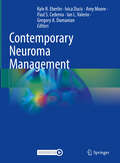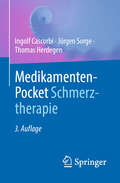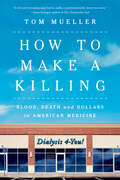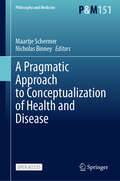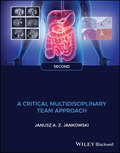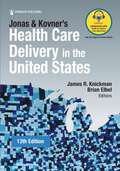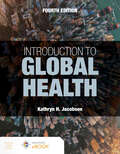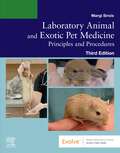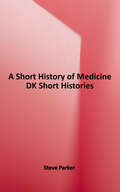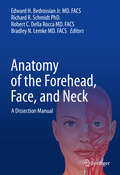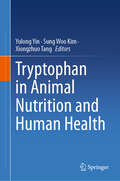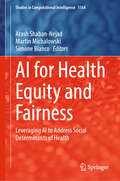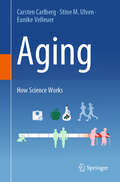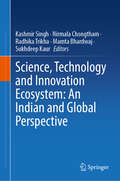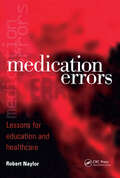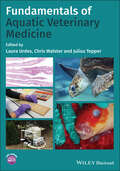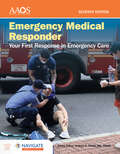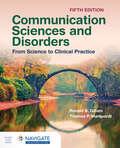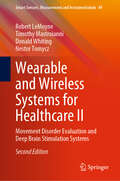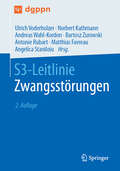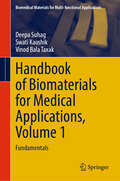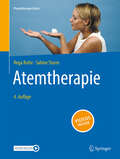- Table View
- List View
Contemporary Neuroma Management
by Kyle R. Eberlin Ivica Ducic Amy Moore Paul S. Cederna Ian L. Valerio Gregory A. DumanianTraditional techniques for the surgical management of symptomatic neuromas involve excision with intra-muscular or intra-osseous burying. Over the last decade, a number of novel strategies have been developed that have led to a resurgence of interest in management of the symptomatic neuroma. These techniques are collectively summarized as active management strategies and include targeted muscle reinnervation (TMR), regenerative peripheral nerve interface (RPNI) and others. This comprehensive text provides a deep dive into the contemporary management of symptomatic neuromas. It discusses the diagnostic workup for neuropathic pain, including the use of imaging and diagnostic nerve blocks, and reviews the epidemiology and demographics of patients presenting with this problem. It then explores non-surgical modalities, as well as both traditional and novel surgical techniques, for the management of symptomatic neuroma. Part of the book is case-based and highlights these techniques, and can serve as a full-color atlas for the peripheral nerve surgeon. Contemporary Neuroma Management presents a concentrated, modern approach to the management of neuromas and will be utilized by peripheral nerve surgeons (plastic surgeons, neurosurgeons, orthopedic surgeons) as well as other pain management providers.
Medikamenten-Pocket Schmerztherapie
by Ingolf Cascorbi Jürgen Sorge Thomas HerdegenMedikamente sind ein zentraler Baustein in der Therapie akuter und chronischer Schmerzen. Dieses Taschenbuch hilft allen in der Allgemeinmedizin und schmerztherapeutisch tätigen Ärztinnen und Ärzten dabei, den Überblick über die Vielzahl von Analgetika für die Behandlung zu bewahren. Hier finden Sie: Pharmakokinetik, Dosierungen und Äquivalenzdosen, Wirkungen, Nebenwirkungen, Wechselwirkungen sowie gesetzliche Grundlagen für die Verordnung von Opioidanalgetika und Cannabionoiden. In der 3. Auflage komplett überarbeitet und um das Kapitel Cannabinoide erweitert.
How to Make a Killing: Blood, Death And Dollars In American Medicine
by Tom Mueller“Inspiring and deeply distressing.” —Ezekiel J. Emanuel, author of Which Country Has the World’s Best Health Care? How did a lifesaving medical breakthrough become a for-profit enterprise that threatens many of the people it’s meant to save? Six decades ago, visionary doctors achieved the impossible: the humble kidney, acknowledged since ancient times to be as essential to life as the heart, became the first human organ to be successfully replaced with a machine. Yet huge dialysis corporations, ambitious doctor-entrepreneurs and Beltway lobbyists soon turned this medical miracle into an early experiment in for-profit medicine—and one of the nation’s worst healthcare catastrophes. With powerful insight and on-the-ground reporting, New York Times best-selling author Tom Mueller introduces an unforgettable cast of characters. Heroic patients, including a Hollywood stuntman and body double, risk their lives to blow the whistle on how they’ve been mistreated. An unpaid activist living in a south Georgia trailer park fights to save patients from involuntary discharge from their lifesaving care. Industry insiders put their careers on the line to speak out about the endemic wrongs and pervasive inequality they’ve witnessed—and about dialysis executives who dress as musketeers and Star Wars characters to exhort their employees to more aggressive profit-seeking. Mueller evokes the scientific ingenuity and optimism of the 1950s and 1960s, when the burgeoning field of organ transplant and early dialysis machines offered long-awaited hope for lifesaving care. That is, until a New York salesman had himself dialyzed on the floor of the House, and Congress made renal disease the only “Medicare for All” condition—opening the financial floodgates for Big Dialysis. Of the thousands caught in a web of corporate greed, a disproportionate number are Black and Latino, highlighting the stark racial divides already endemic to American medicine. How to Make a Killing reveals dialysis as a microcosm of American medicine and poses a vital challenge: find a way to fix dialysis, and we’ll have a fighting chance of fixing our country’s dysfunctional healthcare system as a whole, restoring patients, not profits, as its true purpose.
From One Cell: A Journey Into Life's Origins And The Future Of Medicine
by Ben Stanger“Insightful and erudite.”—Adrian Woolfson, Wall Street Journal Inside the quest to unlock the mysteries of development—and find the key to transforming our future. Each of us began life as a single cell. From this humble origin, we embarked on a risky journey fraught with opportunities for disaster. Yet, amazingly, we reached our destination intact, emerging as dazzlingly complex, exquisitely engineered assemblages of trillions of cells. This metamorphosis constitutes one of nature’s most spectacular yet commonplace magic tricks—and one of its most coveted secrets. In From One Cell, physician and researcher Ben Stanger offers a breathtaking glimpse into what scientists are discovering about how life and the body take shape, and how these revelations stand to revolutionize medicine and the future of human health. In vivid prose, Stanger leads readers on a gripping odyssey retracing this universal, yet unremembered, rite of passage. Through the eyes of the scientists unraveling development’s riddles in experiments as painstaking as they are inventive, we confront fascinating puzzles: how does the plethora of different tissues that compose our bodies arise from a single source? How do cells know what they are meant to become—skin or bone, blood or muscle—when all carry the same set of genetic instructions? Once a cell starts developing down one path, can it change its mind, or is its destiny irrevocably sealed? As Stanger shows us, the answers to these questions may at last empower us to solve some of our most persistently confounding medical challenges, from cancer to cognitive decline to degenerative disease. Recognizing tumors as evil doppelgangers of the embryo points the way toward new, more targeted cancer therapies. Learning how cells choose their identities and find their way in space could unlock lifesaving breakthroughs in regenerative medicine. The possibilities are extraordinary. Popular science at its best, From One Cell celebrates the power and beauty of understanding our collective beginnings.
A Pragmatic Approach to Conceptualization of Health and Disease (Philosophy and Medicine #151)
by Maartje Schermer Nicholas BinneyThis open access book is an integrated historical and philosophical investigation of several problematic situations that emerge from diverse areas of medical practice. These include (but are not limited to): Paying less attention to patients who are suffering with symptoms because no identifiable pathological lesion or pathophysiological process can be found. Paying too much attention to patients who are not suffering with symptoms because pathological lesions or pathophysiological processes have been found. The tendency to understand patients at risk of developing pathology as being diseased. The tendency to disregard the importance of wider societal consequences of definitions of disease and health. The book shows that many of these problems are related to what disease and health are considered to be and argues that these problems can be addressed by reconsidering the concepts of health and disease employed in practice. It argues for a pragmatic reconceptualization of health and disease that allows clinicians, researchers, and lay people to understand health and disease in many ways, depending on the specific context in which they find themselves and the problems they are trying to solve. In doing so, authors are careful to show how this pragmatism does not endorse “silly” forms of relativism, in which knowledge is reduced to belief or to whatever people find expedient to believe. This work is relevant for philosophers and historians a well as for doctors, health policy makers and other health professionals because it addresses problems sourced from medical practice, albeit using philosophical and historical methods.
Praktijkboek eetstoornissen: Achtergrond, diagnostiek en behandeling
by P. J. Daansen E. M. Elske Van Den BergDit praktijkboek helpt behandelaren bij de diagnose en behandeling van eetstoornissen. Het biedt praktische handvatten voor iedere hulpverlener, ervaren of junior, die eetstoornissen tegenkomt in de dagelijkse praktijk. Praktijkboek eetstoornissen: Achtergrond, diagnostiek en behandeling bestaat uit drie delen. De eerste hoofdstukken behandelen een aantal theoretische aspecten, zoals risicofactoren, comorbiditeit en epidemiologie. Daarbij legt het boek steeds een link naar de praktijk. Het tweede deel bespreekt de behandeling van de vier meest voorkomende eetstoornissen: anorexia nervosa, boulimia nervosa, binge eating disorder en ARFID. Centraal staan daarbij de relevante vragen voor het therapeutisch handelen: hoe kom je tot een passende diagnose? Aan welke differentiaaldiagnostiek moet je denken? Voor welk behandelmodel kies je? Het derde deel gaat ten slotte in op specifieke doelgroepen, aan de hand van uitgebreide casuïstiek. Het boek wordt in het vierde deel afgesloten met een concluderend hoofdstuk en enkele aanbevelingen voor de toekomst.
Gastrointestinal Oncology: A Critical Multidisciplinary Team Approach
by Professor Janusz A. Z. Jankowski JPGASTROINTESTINAL ONCOLOGY Blends quality research findings with advanced educational techniques in a uniquely comprehensive approach Written and edited by leading international experts in the field, Gastrointestinal Oncology: A Critical Multidisciplinary Team Approach is an indispensable reference for clinicians, medical practitioners, and trainees involved in the investigation, diagnosis, and treatment of esophageal, gastric, intestinal, colonic, hepatobiliary, pancreatic, and other gastrointestinal tumors. Drawing on the most current evidence-based knowledge, this comprehensive resource reflects the current care of GI cancer patients, enabling effective clinical decision making and patient management. Setting the standard in clinical practice, Gastrointestinal Oncology remains the only truly multidisciplinary reference designed for the diverse team of clinicians responsible for different stages of cancer treatment. Specially structured clinical chapters, each representing a different role in the multidisciplinary team (MDT), allow clear presentation and quick reference of the contents. This is supported by a wealth of high-quality color photographs, line drawings, and diagrams. Now in its second edition, this authoritative reference is fully updated to reflect groundbreaking research in multiple medical fields, including the explorative use of A.I. New sections on palliative care and nutrition are accompanied by new sub-sections on molecular characterization, new targeted small molecule, receptor options, and immunological therapies for each cancer. This edition places renewed emphasis on the most ubiquitous conditions, such as colon cancer, liver cancer, and gastro-esophageal cancer. Covering the oncology of the entire gastrointestinal tract, Gastrointestinal Oncology: A Critical Multidisciplinary Team Approach is a must-have reference for the entire MDT, including gastroenterologists, hepatologists, GI surgeons, medical oncologists, radiation therapists, interventional radiologists, pathologists, nutritionists, palliative care and specialist nurses, as well as clinical scientists.
Health Care Delivery in the United States
by James R. Knickman Brian ElbelThis comprehensive textbook contains information on a wide array of topics, including the organization of care, population health, the fundamental challenges of health disparities, health care financing and economics, and health information technology’s role in improving care and protecting privacy. New chapters on public health preparedness and its role in mitigating effects on health and the health system and the medical and social challenges of caring for older adults provide insight into important, ongoing challenges and what those challenges reflect about our system of care.<p><p> With an increased emphasis on health disparities, population health, and health equity, this textbook includes a timely focus on how social and behavioral determinants influence health outcomes. Students will gain a deeper understanding of public health systems and their societal role and of the economic perspectives that drive health care managers and the system. Thorough coverage of the rapid changes that are reshaping our system, in addition to an evaluation of our nation’s achievement of health care value, will equip students with the critical knowledge they need to enter this dynamic and complex field. The book also includes cutting-edge, evidence-based information on preventive medicine, innovative approaches to control health care costs, initiatives to achieve high-quality and value-based care, and much more from prominent scholars, practitioners, and educators within health care management, public health, population health, health policy, medical care, and nursing.
Introduction to Global Health
by Kathryn H. JacobsenIntroduction to Global Health is a comprehensive look at today’s most critical global health concerns and the actions that people around the world are taking to solve public health problems and to promote health and wellbeing. The Fourth Edition of Introduction to Global Health maintains the clarity and ease of use of the prior edition, while featuring a greater emphasis on the specific interventions that are being implemented to promote longer, healthier lives worldwide and prevent disease, disability, and early death in countries of all income levels. Every chapter balances material about pandemics, climate change, and other emerging threats to global public health with evidence of how global health interventions are enabling progress toward achieving health equity.
Laboratory Animal and Exotic Pet Medicine
by Margi SiroisLearn the veterinary technician's role in the care of exotic pets and animals used in biomedical research! Laboratory Animal and Exotic Pet Medicine: Principles and Procedures, 3rd Edition helps you gain the knowledge and skills needed to ensure animal health and well-being. It covers animal husbandry, restraint and handling, and diseases, and provides guidelines to key clinical procedures such as blood collection, medication administration, anesthesia, and diagnostic imaging. Research-related information addresses the ethical concerns of exotic pet ownership, as well as the benefits and humane use of animals in research. Written by noted veterinary technology educator Margi Sirois, this text is a must-have resource for all caretakers of lab animals. Comprehensive coverage prepares you to work with all types of animals by addressing a wide variety of species including rats, mice, rabbits, guinea pigs, ferrets, hamsters, gerbils, nonhuman primates, amphibians, fish, reptiles, birds, farm animals, and cats and dogs; it also covers topics such as animal species, the laboratory setting, regulatory guidelines, and ethical considerations. Consistent organization of each species chapter makes it easy to quickly identify similarities and differences among various laboratory animals. Current information on legal, moral, and ethical issues includes legal requirements, the protocols guiding lab animal use, animal exploitation, and animal rights. Discussion of specific uses for each species in biomedical research provides a perspective that helps you explain the benefits of animal use in providing high-quality research data. Technician Notes highlight important points and provide helpful tips to improve your knowledge and skills. Learning objectives, key points, and chapter review questions make studying easier. NEW! Comprehensive coverage of poultry includes the increasingly popular backyard chickens, as well as commonly performed procedures and in-depth information on housing, restraint, nutrition, common diseases, diagnostics, and therapeutics. NEW photographs show the latest technology available in laboratory and exotic animal medicine.
A Short History of Medicine (Dk Short Histories Ser.)
by Steve ParkerImmerse yourself in the history of medicine – a colorful story of skill, serendipity, trial and error, moments of genius, and dogged determination. From traditional Chinese medicine to today’s sophisticated gene therapies and robotic surgery, A Short History of Medicine combines riveting storytelling and beautiful images, historical accounts, and lucid explanations, to illuminate the story of medicine through time. Witness early, bloody, anesthetic-free operations; see the first crude surgical instruments; trace the mapping of the circulatory system; follow the painstaking detective work that led to the decoding of the human genome; and understand the role that potions, cures, therapies, herbal medicines, and drugs have played in the human quest to tame and conquer disease, injury, and death. Dive deep into this magnificent medicine book to discover: - Vivid, compelling, and informative reads written in an engaging and colorful style - Excerpts from documents, diaries, and notebooks offer fascinating eyewitness accounts. - Charts and contextualizes the great milestones of medical history. A Short History of Medicine is a fascinating illustrated history and tale of drama and discovery that celebrates the milestones of medical history across generations and cultures. From eradicating smallpox to the early anesthetics, the very first transplants to the genetic code, this groundbreaking guide to the history of medicine has something for everyone to explore, learn, and discover. Ideal for adults and young adults alike, whether you have a keen interest in medicine, science or social history, this all-encompassing medicine book is sure to quench your thirst for knowledge!
Anatomy of the Forehead, Face, and Neck: A Dissection Manual
by Richard R. Schmidt Robert C. Della Rocca Bradley N. Lemke Edward H. Bedrossian Jr.Like its companion volume, Anatomy of the Eyelid, Orbit, and Lacrimal System: A Dissection Manual, this unique dissection manual provides a detailed step-by-step approach to the dissection of the forehead, face, and neck, in a structural, layered approach. This dissection manual follows an atlas format, with color photographs from past professional lectures and classroom courses, as well as line drawings, enhancing descriptions. Clinical correlations are also interjected throughout to highlight the importance of individual anatomic structures. Chapters describe the preparation and storage of specimens and the dissection of the forehead and eyebrows, the midface, nose, ear, and lower face, and the neck. Anatomy of the Forehead, Face, and Neck: A Dissection Manual is an expertly written, invaluable resource for surgeons seeking to enhance their knowledge and surgical skills.
Tryptophan in Animal Nutrition and Human Health
by Yulong Yin Sung Woo Kim Xiongzhuo TangThis book integrates the research progress of Tryptophan (Trp) and its metabolites in animal nutrition and human health. It recapitulates the effects of Trp nutrition on the regulation of various physiological functions in farmed animals as well as the clinical connections between Trp metabolism and human diseases. Furthermore, this book includes detailed information about the manufacturing process of industrial Trp production and methodologies to study Trp metabolism. This book not only brings numerous benefits to academic communities worldwide but also provides practical values for industrial professionals/companies. Both of these two aspects will expand our understanding of how amino acid metabolism contributes to the maintenance of host health.
AI for Health Equity and Fairness: Leveraging AI to Address Social Determinants of Health (Studies in Computational Intelligence #1164)
by Simone Bianco Arash Shaban-Nejad Martin MichalowskiThis book aims to highlight the latest achievements in the use of AI for improving Health Equity and Fairness. The edited volume contains selected papers presented at the 2024 Health Intelligence workshop, co-located with the Thirty-Eight Association for the Advancement of Artificial Intelligence (AAAI) conference, and presents an overview of the issues, challenges, and potentials in the field, along with new research results. This book provides information for researchers, students, industry professionals, clinicians, and public health agencies interested in the applications of AI in medicine and public health.
Aging: How Science Works
by Carsten Carlberg Eunike Velleuer Stine M. UlvenAging is a topic that concerns all of us, since none of us can escape it. The molecular and cellular process is built in every of the billions of cells forming our body. Some of these cells, such as immune cells and red blood cells, live only for a few days to weeks and get life-long constantly replaced by cells produced in the bone marrow. In contrast, there are cells, such as neurons and memory lymphocytes, that get as old as we get. The process of aging limits our maximal life span, which is for our humans 120 years. However, only a very few individuals reached this age. How did their life differ from others that died decades earlier? Is it just the absence of life threatening disease paired with a more healthy life style? Or is it build in in our genome or epigenome? In this book we try to give answers to these questions from the perspectives of evolution, our genome, the epigenomes of our different tissues and cell types and the functionality of our cells. We should try to understand ourselves in detail as well as in a global setting. Basic biology explains cellular mechanisms, such as growth, differentiation, and cell death, which make life as a whole possible. Every (human) organism represents a complex interplay between hundreds of different cell types forming distinctive tissues and organs with specialized tasks. These processes need to be highly orchestrated especially during development, maintenance and aging. Studying the cellular and molecular basis of aging is one of the most fascinating areas but also a great challenge. Nevertheless, research made the biggest steps in elucidating biological processes via studying malfunctions of normal mechanisms leading to different diseases, such as progeroid syndrome and cancer. We will start this book with the understanding of the human genome in relation to principles of evolution. Then we will explain the basics of gene regulation and epigenetics, i.e., the interplay of transcription factors and chromatin. Next, we will shift to cellular mechanisms of aging and discuss then the impact of nutrition and immunity on the aging process. In the following the relation of aging to so-called aging-related common diseases, such as type 2 diabetes, atherosclerosis, cancer and Alzheimer. Do we get these diseases because we are aging or are we aging because we get one of these diseases? The book will end how we can slow down the aging process so that we can age healthy. In short, healthy aging is not an option but is a must. An ancient poem says “Teach us to number our days, that we may get a heart of wisdom.” It is up to each one of us and a daily decision to live a healthy lifestyle and to be aware of the unique gift of live we all have.
Science, Technology and Innovation Ecosystem: An Indian and Global Perspective
by Nirmala Chongtham Kashmir Singh Radhika Trikha Mamta Bhardwaj Sukhdeep KaurScience, Technology, and Innovation (STI) are the key drivers of the economy and development of a country. The economic and social impacts of STI require a deep understanding of the STI ecosystem, which includes the interactions between actors, their technologies, and their business models. This book, "Science, Technology, and Innovation Ecosystems: A National and Global Perspective," focuses on the STI ecosystem of India in comparison to other innovation-backed global countries. It will include a study of the entire STI ecosystem, focusing on the system interconnectedness required for strengthening it. The building of interconnection within actors of the STI ecosystem is one of the paramount requirements to reinvigorate the STI ecosystem as a whole. The book will also present the crucial role of STI in bringing socio-economic development from a national and international perspective. It addresses the development of viable solutions for a sustainable future and a positive societal transformation with the help of innovative science-based approaches. This book showcases the future of science in terms of emerging frontier and strategic technologies, giving us a snapshot of future STI efforts worldwide. Emphasis is given to the policy directives and program interventions backed by evidence to revamp the STI system by addressing the societal and economic needs of the country. The book will strategically bring the concept of the relevance of the Intellectual Property (IP) ecosystem in building the country’s innovation capacity along with specific pieces of evidence on how the IP system should be roped in to bring higher innovation efficiency. An insight is provided to chart out the pathway for creating a knowledge-based economy focusing on knowledge production to knowledge consumption through knowledge diffusion.
Medication Errors: Lessons for Education and Healthcare
by Robert NaylorAdverse events in patients caused by medical management are a serious and grossly underreported public health problem. One patient in ten entering hospital will suffer an adverse event of impairment, disability or death. This book is a major comprehensive examination of the incidence and causes of adverse events. Using data obtained from hospitals within the United Kingdom, United States and other developed countries, it examines the risk factors leading to errors, the human and financial costs, and the scope to reduce errors. In particular, it focuses on the need for a critical reappraisal of undergraduate teaching and clinical tuition. All healthcare professionals throughout primary and secondary care, including clinicians, managers and policy makers, and patient and carer groups, can benefit from reading this book. It identifies possible solutions and how adverse events and medication errors can be reduced, resulting in improved patient care.
Fundamentals of Aquatic Veterinary Medicine
by Laura Urdes Chris Walster Julius TepperFundamentals of Aquatic Veterinary Medicine Covers the competencies necessary to assure the highest quality of aquatic veterinary services Fundamentals of Aquatic Veterinary Medicine provides systematic, highly practical guidance on the treatment of aquatic mammals, amphibians, fish, and invertebrates in veterinary practice. Mapping to each of the nine core areas of the WAVMA Certified Aquatic Veterinarian (CertAqV) Program, this comprehensive clinical reference covers taxonomy, anatomy and physiology of aquatic species, water quality and life support systems, diagnostics, treatment, and prevention of aquatic diseases, and more. Designed to help readers acquire and demonstrate the necessary knowledge, skills, and experience to be competent in aquatic veterinary medicine, this authoritative guide: Focuses on "Day One" competencies outlined by the World Organization for Animal Health (OIE) Covers pathobiology and epidemiology of aquatic diseases, public health, zoonotic diseases, and seafood safety Provides up-to-date information on relevant legislation, regulations, and policies Fundamentals of Aquatic Veterinary Medicine is a must-have reference and review guide for veterinary students and practitioners interested in practicing aquatic veterinary medicine, as well as for aquatic veterinarians looking to become WAVMA certified or wanting to acquire OIE "Day One" competency.
Emergency Medical Responder: Your First Response In Emergency Care
by American Academy of Orthopaedic Surgeons (AAOS)Based on the National EMS Education Standards and endorsed by the American Academy of Orthopaedic Surgeons, Emergency Medical Responder: Your First Response in Emergency Care, Seventh Edition clearly and concisely covers every competency required of students embarking on this vital EMS role.
Communication Sciences and Disorders: From Science to Clinical Practice
by Ronald B. Gillam Thomas P. MarquardtCommunication Sciences and Disorders: From Science to Clinical Practice, Fifth Edition is the ideal introductory text for undergraduate students enrolled in their first course in communication sciences and disorders. Written by experts in the field, this text contains fundamental information about speech disorders that are related to impairments in articulation, voice, and fluency, while providing the essential information on the speech, language, and hearing sciences combined with practical information about assessment and intervention practices. This new edition provides readers with a wide-angle view of communication disorders, covering the variety of topics that speech, language, and hearing scientists study, and the variety of individuals that Audiologists and Speech-Language Pathologists treat.
Ten Fingers for God: The Complete Biography of Dr. Paul Brand
by Dorothy C. WilsonTen Fingers for God describes the extraordinary servanthood--the life of Dr. Paul Brand, a medical doctor, whose life and work have been a blessing to countless thousands of leprosy victims on five continents. Through surgeries (over 3,000 in India alone), the pioneering research he has conducted and inspired, and his empathy for the poor and forsaken. Dr. Brand has achieved fame in the medical world. Dr. Brand's professional life has centered on perhaps the most problematic aspect of creation, the existence of pain. His conviction that the function of pain in the human body is a disguised blessing to the human race. He felt that "God designed the human body so that it is able to survive because of pain. As a surgeon, teacher, and environmentalist. Dr. Brand 'has chosen the middle way of balancing the material and the mystical, the prophetic and the pragmatic. His spirit of self-sacrifice and humility can best be distilled by his sureness that "it is a pity that a man has only one life to spend, one pair of feet, two hands, ten fingers! Paul Brand is an adventure loving, highly spiritual surgeon who discovers his life's calling is to improve the hands and feet of people with leprosy worldwide. He developed techniques for returning functionality to disfigured, numb hands and feet and goes on to establish centers where patients receive protective shoes and learn skills to become employable. Paul both teaches others in many countries to help in his mission and learns from other doctors, scientists and rehabilitation specialists. In his travels and impassioned, informative speeches he raises awareness of this disease which is only contagious for a brief time and inspires people to pool their resources to improve care for a population ending their generations old fate of being shunned, ostracized and forced to beg for their survival.
Wearable and Wireless Systems for Healthcare II: Movement Disorder Evaluation and Deep Brain Stimulation Systems (Smart Sensors, Measurement and Instrumentation #49)
by Timothy Mastroianni Robert LeMoyne Donald Whiting Nestor TomyczThis book is the second edition of the one originally published in 2019. The original publication features the discovery of numerous novel applications for the use of smartphones and portable media devices for the quantification of deep brain stimulation for the treatment of movement disorders that constitute first-in-the-world applications for these devices. Since the first edition, numerous evolutions involving the domain of wearable and wireless systems for healthcare and deep brain stimulation have transpired warranting the publication of the second edition. This volume covers wearable and wireless systems for healthcare that are far more relevant to the unique requirements of the domain of deep brain stimulation. The paradigm-shifting new wearables comprising attributes of conformability and further miniaturization have been recently applied for the context of deep brain stimulation. Additionally, the subjects of automated optimization for deep brain stimulation and the rampantly expanding additional applications for deep brain stimulation are addressed. The authors expect that these significant developments make this book valuable for all readers.
S3-Leitlinie Zwangsstörungen
by Ulrich VoderholzerDie erste Revision der S3-Leitlinie zur Behandlung von Zwangsstörungen bei Erwachsenen wurde wieder unter Beratung und Moderation durch die Arbeitsgemeinschaft der wissenschaftlichen medizinischen Fachgesellschaft (AWMF) von einem großen Gremium an wissenschaftlichen Experten und Vertretern von Fachverbänden erstellt. Die Empfehlungen der revidierten Fassung basieren auf einer Sichtung der Evidenz der verfügbaren randomisierten klinischen Studien zu Zwangsstörungen sowie der Meta-Analysen dazu, einer Synthese der Empfehlungen anderer Leitlinien sowie einem Expertenkonsens bei den Fragen, zu denen es keine Evidenz aus Studien gibt. Aufgrund der großen Datenbasis sowie der breiten klinischen Erfahrungen von Experten auf dem Gebiet können in dieser Leitlinie konkrete und fundierte Empfehlungen für die Behandlung der Zwangsstörungen gegeben werden. Änderungen der ersten Revision der Leitlinie im Vergleich zur Ursprungsversion aus dem Jahre 2013 betreffen insbesondere die weitere Stärkung des Stellenwertes der kognitiven Verhaltenstherapie mit Exposition, die nach neueren Meta-Analysen das wirksamste Therapieverfahren und daher Therapie der ersten Wahl ist. Neu ist die Empfehlung für hochfrequente Expositionsübungen, z.B. im Blockformat, die, wo die Voraussetzungen vorliegen, genutzt werden sollten. Darüber hinaus wurden Empfehlungen zur Pharmakotherapie bei Therapieresistenz wesentlich überarbeitet, weil es in diesem Bereich in den vergangenen 10 Jahren viele neue Studien gab. Weitere neue Empfehlungen betreffen spezielle Behandlungsaspekte, den Umgang mit Komorbidität und die Versorgung, die in der ursprünglichen Leitlinie nicht enthalten waren.
Handbook of Biomaterials for Medical Applications, Volume 1: Fundamentals (Biomedical Materials for Multi-functional Applications)
by Deepa Suhag Swati Kaushik Vinod Bala Taxak"Handbook on Biomaterials for Medical Applications: Fundamentals" is a critical monograph that merges advanced technological insights with practical applications in biomedical materials science. It navigates through the intricate blend of theoretical knowledge and real-world medical practices, highlighting the significant roles these materials play in enhancing therapeutic outcomes. Addressing the interdisciplinary nature of the field, the book incorporates perspectives from chemistry, biology, engineering, and clinical medicine. This comprehensive guide covers novel biomaterials, advanced drug delivery systems, innovative tissue engineering, and the emerging field of theranostics, providing a holistic view of how these elements drive medical advancements. This book can be a valuable reference for scholars, researchers, and healthcare practitioners. Its text is richly illustrated with diagrams and tables, facilitating both the understanding and application of complex concepts. With an educational narrative accessible to both experts and beginners, the monograph encourages a passion for innovation and a deep understanding of the transformative potential of multifunctional biomedical materials. It invites readers to explore the confluence of materials science and therapeutic innovation, setting the stage for future breakthroughs in medical science and therapy. It can also be prescribed as a textbook for various graduate and undergraduate courses like tissue engineering and regenerative medicine, nanomedicine, biomedical engineering and biomaterials science and engineering.
Atemtherapie (Physiotherapie Basics)
by Rega Rutte Sabine SturmDieses Lehr- und Praxisbuch vermittelt alle wesentlichen Grundlagen und Vorgehensweisen der atemtherapeutischen Behandlung in der Physiotherapie. Woran erkenne ich im Rahmen des Befundes, ob Atemhilfsmuskeln eingesetzt werden? Mit welchen Kräftigungsübungen für Rumpf- und Armmuskulatur kann die allgemeine Belastbarkeit verbessert werden? Wie genau funktionieren „Jane Cool“ oder der „Heuler“? Die Expertinnen liefern Ihnen die Antworten! Aus dem Inhalt: Anatomische und physiologische Grundlagen, Wirkungsprinzipien, Befund- und Behandlungsplanung, Atemtherapeutische und ergänzende Maßnahmen mit und ohne Hilfsmittel, Behandlungsbeispiele für häufige Krankheitsbilder, wie z. B. COPD und Asthma bronchiale. Plus: Videos zu Übungseinheiten via Springer Nature More Media-AppGanz gleich ob COPD, Lungentransplantation oder Pneumothorax: Mit diesem Buch sind Sie für alle atemtherapeutischen Herausforderungen gewappnet!
